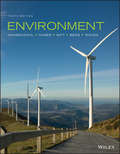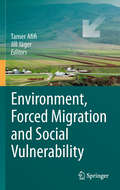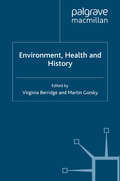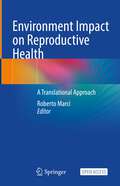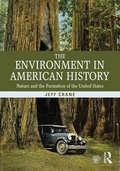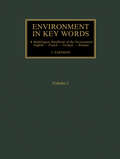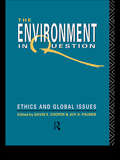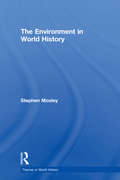- Table View
- List View
Environment, Energy and Climate Change II: Energies from New Resources and the Climate Change (The Handbook of Environmental Chemistry #34)
by Gilles Lefebvre Elena Jiménez Beatriz CabañasThis volume provides a comprehensive overview of advanced research in the field of efficient, clean and renewable energy production, conversion and storage. The ten chapters, written by internationally respected experts, address the following topics: (1) solar and wind energy; (2) energy storage in batteries; (3) biomass; and (4) socio-economic aspects of energy.Given its multidisciplinary approach, which combines environmental analysis and an engineering perspective, the book offers a valuable resource for all researchers and students interested in environmentally sustainable energy production, conversion, storage and its engineering.
Environment, Energy and Sustainable Development
by Wen-Pei Sung Ran Chen Jimmy C. M. KaoEnvironment, Energy and Sustainable Development brings together 242 peer-reviewed papers presented at the 2013 International Conference on Frontiers of Energy and Environment Engineering, held in Xiamen, China, November 28-29, 2013.The main objective of this proceedings set is to take the environment-energydevelopments discussion a step further. Vo
Environment, Enhanced eText
by Linda R. Berg Peter H. Raven David M. Hassenzahl Mary Catherine Hager Nancy Y. GiftEnvironment, Tenth Edition helps students understand the connection between the core concepts of the Environmental Science and their daily lives. The 10th edition enhanced e-text features a rich, interactive collection of current case studies and in-text examples, which provides students with the tools to understand, apply, and think critically about environmental science. It also provides instructors with powerful tools to assess individual students progresses well as the class as a whole.
Environment, Forced Migration and Social Vulnerability
by Tamer Afifi Jill JägerThis book is one of the outputs of the conference on ‘Environmental Change, Forced Migration, and Social Vulnerability’ (EFMSV) held in Bonn in October 2008. Migration is one of the oldest adaptation measures of humanity. Indeed, without migration the multitude of civilizations and interactions between them – peaceful and otherwise – would be hard to imagine. The United Nations (UN)-led global dialogue on migration is a clear sign that governments and the specialized UN agencies and bodies have recognized the need to view, govern, manage, and facilitate migration; to mitigate its negative effects; and to capitalize on the positive ones. It is a common expectation among experts that environmentally induced migration will further increase in the decades to come. Hence, next to the political, economic, ethnic, social, financial, humanitarian, and security aspects of migration, the environmental component should urgently be considered in the ongoing international dialogue on migration. This need is also a challenge. Without appropriate scientific knowledge, assessment, definitions, and classifications, the intergovernmental frameworks would not be able to deal with these complex phenomena. The Five-Pronged-Approach as formulated by the United Nations University (UNU) may serve as a framework to identify the additional dimensions of this challenge next to – and actually simultaneously with – the scientific one.
Environment-Friendly Antiviral Agents for Plants
by Baoan Song Song Yang Lin-Hong Jin Pinaki S. BhaduryPlant virus disease is a worldwide threat to agriculture. Environment-Friendly Antiviral Agents for Plants systematically describes the basic theory, new ideas, and new methods to discover novel antiviral agents through research on plant immune activation. The cutting-edge research methodology, technology and progress on novel antiviral agent innovation are systematically described. With abundant illustrations and figures, the book is intended for researchers and practitioners in the fields of pesticide science, plant protection, organic chemistry, fine chemicals, applied chemistry, environment chemistry and agriculture science. Dr. Baoan Song and Dr. Song Yang are professors at the Center for R&D of Fine Chemicals, Guizhou University, China; Mr. Linhong Jin and Dr. Pinaki S. Bhadury are associate professors there.
Environment-Friendly Techniques of Rock Breaking
by Ajoy K. Ghose Janus Res K. WladzielczykSignificant advances have been made in non-explosive rock breaking techniques in the past two decades. This monograph focuses specifically on environmental-friendly rock excavating using chemical, thermal, hydraulic, electric and hybrid systems. It presents a comprehensive overview of the theoretical concepts and state-of-the-art practical developments based on these emerging techniques.
Environment-Friendly Techniques of Rock Breaking
by Ajoy K. Ghose Janus Res K. WladzielczykSignificant advances have been made in non-explosive rock breaking techniques in the past two decades. This monograph focuses specifically on environmental-friendly rock excavating using chemical, thermal, hydraulic, electric and hybrid systems. It presents a comprehensive overview of the theoretical concepts and state-of-the-art practical developments based on these emerging techniques.
Environment, Health and History
by Virginia Berridge Martin GorskyThe environment is currently a matter of international public and academic concern, but is often considered separately from health issues. This book brings together work from environmental and health historians to conceptualise the connection between environment and health at different times and in different geographical locations.
Environment Impact Assessment: Precept & Practice
by K. M. Baharul Islam Zafar Mahfooz NomaniEnvironment Impact Assessment: Precept & Practice deals with theoretical, practical, managerial and legal issues in multidisciplinary holism to suit Indian environmental planning and governance. Environment Impact Assessment is not only considered a tool for sustainable development but a promissory augury of creation of equitable regime of for ecosystem governance. The book is laced with polemical issues in dexterous detail to cater erudite demand of environmental planners besides fulfilling the void of curriculum and pedagogic requirements of technical universities, environmental management and legal studies. The book offers diversity of thoughts across discipline on Environment Impact Assessment discourse in rounded perspective having immense potential for textual and reference utilities. The treatment of subject is not only discursive but paradigmatic to eradicate contemporary crisis in Environment Impact Assessment regime. It combines theoretical postulate with deeper empiricism and penetrative case studies to make an intriguing subject of Environment Impact Assessment with greater ease and lucidity. Note: T&F does not sell or distribute the Hardback in India, Pakistan, Nepal, Bhutan, Bangladesh and Sri Lanka.
Environment Impact Assessment: Precept & Practice
by K. M. Baharul Islam; Zafar Mahfooz NomaniEnvironment Impact Assessment: Precept & Practice deals with theoretical, practical, managerial and legal issues in multidisciplinary holism to suit Indian environmental planning and governance. Environment Impact Assessment is not only considered a tool for sustainable development but a promissory augury of creation of equitable regime of for ecosystem governance. The book is laced with polemical issues in dexterous detail to cater erudite demand of environmental planners besides fulfilling the void of curriculum and pedagogic requirements of technical universities, environmental management and legal studies. The book offers diversity of thoughts across discipline on Environment Impact Assessment discourse in rounded perspective having immense potential for textual and reference utilities. The treatment of subject is not only discursive but paradigmatic to eradicate contemporary crisis in Environment Impact Assessment regime. It combines theoretical postulate with deeper empiricism and penetrative case studies to make an intriguing subject of Environment Impact Assessment with greater ease and lucidity. Note: T&F does not sell or distribute the Hardback in India, Pakistan, Nepal, Bhutan, Bangladesh and Sri Lanka.
Environment Impact on Reproductive Health: A Translational Approach
by Roberto MarciThis open access book focuses on of the impact of endocrine disrupting chemicals (EDCs) on human reproduction. It comprehensively discusses the three most important topics in the field: the basic biology of EDCs; the effects of EDCs on human reproduction and human reproductive systems; and potential interventions and practical advice for dealing with the problems caused by EDCs.Presenting a translational approach to endocrine disrupting chemicals research, spanning both basic biology and clinical applications, the book provides a critical link between laboratory investigations and clinical practice. Written by international experts in the field, it is a valuable reference resource for gynaecologists, obstetricians, endocrinologists and experts in reproductive medicine, and a useful tool for anyone interested in the impact of the environment on human reproduction.
The Environment in American History: Nature and the Formation of the United States
by Jeff CraneFrom pre-European contact to the present day, people living in what is now the United States have constantly manipulated their environment. The use of natural resources – animals, plants, minerals, water, and land – has produced both prosperity and destruction, reshaping the land and human responses to it. The Environment in American History is a clear and comprehensive account that vividly shows students how the environment played a defining role in the development of American society. Organized in thirteen chronological chapters, and extensively illustrated, the book covers themes including: Native peoples’ manipulation of the environment across various regions The role of Old World livestock and diseases in European conquests Plantation agriculture and slavery Westward expansion and the exploitation of natural resources Environmental influences on the Civil War and World War II The emergence and development of environmental activism Industrialization, and the growth of cities and suburbs Ecological restoration and climate change Each chapter includes a selection of primary documents, and the book is supported by a robust companion website that provides further resources for students and instructors. Drawing on current scholarship, Jeff Crane has created a vibrant and engaging survey that is a key resource for all students of American environmental history.
The Environment in American History: Nature and the Formation of the United States
by Jeff CraneFrom pre-European contact to the present day, people living in what is now the United States have constantly manipulated their environment. The use of natural resources – animals, plants, minerals, water, and land – has produced both prosperity and destruction, reshaping the land and human responses to it. The Environment in American History is a clear and comprehensive account that vividly shows students how the environment played a defining role in the development of American society. Organized in thirteen chronological chapters, and extensively illustrated, the book covers themes including: Native peoples’ manipulation of the environment across various regions The role of Old World livestock and diseases in European conquests Plantation agriculture and slavery Westward expansion and the exploitation of natural resources Environmental influences on the Civil War and World War II The emergence and development of environmental activism Industrialization, and the growth of cities and suburbs Ecological restoration and climate change Each chapter includes a selection of primary documents, and the book is supported by a robust companion website that provides further resources for students and instructors. Drawing on current scholarship, Jeff Crane has created a vibrant and engaging survey that is a key resource for all students of American environmental history.
The Environment in Asia Pacific Harbours
by Eric WolanskiUrbanization has reached unprecedented levels in the estuarine and coastal zone, particularly in the Asia Pacific region where mega-cities and mega-harbours are still growing. This book demonstrates the different solutions and pitfalls, successes and failures in a large number of ports and harbours in the Asia Pacific Region, and shows how science can provide ecologically sustainable solutions that apply wherever the growth of mega-harbours occurs.
The Environment in Economics and Development: Pluralist Extensions of Core Economic Models (SpringerBriefs in Economics)
by Vikram DayalThis brief views the environment through diverse lenses – those of standard economics, institutional economics, political science, environmental science and ecology. Chapter 2 discusses diverse theoretical and statistical models – constrained optimization models, game theory, differential equations, and statistical models for causal inference – in a simple manner. Developing countries have certain distinct environmental problems – traditional pollution and traditional dependence on the commons. While chapters 3 and 4 discuss these specific problems, statistical graphs of the World Development Indicators explore the macro-context of developing countries in chapter 1. Chapter 5 examines ecological systems, which are nonlinear and unpredictable, and subject to sudden regime shifts. Chapter 6 deals with the global challenges of climate change and biological invasions. The last chapter discusses sustainable development and institutions. The brief explains these topics simply; mathematics is largely confined to an appendix. The broad treatment and simple exposition will appeal to students new to the field of economics. The extension of core economic models in diverse directions will also be of interest to economists looking for a different treatment of the subject.
The Environment in Galicia: Galician Environment Through Images
by Avelino Núñez-Delgado Esperanza Álvarez-Rodríguez David Fernández-CalviñoThis book describes the environment in Galicia (NW Spain), with researchers and professors presenting their own photographs of relevant aspects. This richly illustrated book explains atmospheric, geologic, water, soils, landscapes, and environmental issues and treatments for a broad audience, including students and the general public, to raise awareness and effectively develop strategies to meet the Sustainable Development Goals.
Environment in Key Words: A Multilingual Handbook of the Environment
by Isaac PaensonEnvironmental problems ignore international boundaries. Toxic wastes travel by water and air, sometimes displacing the effects of an environmental disaster entirely outside of its country of origin. It is now understood that to overcome the problems that face us international co-operation is required. This important work is designed to assist in that process, by helping to break down the language barriers that stand between countries. The manual, written in parallel English, German, French and Russian texts, provides the basic tools of communication in the specialized fields of environmental sciences between speakers of these languages. Each chapter has been revised in each separate language by specialists in the field to guarantee the authenticity of the information presented. The author is unique in his approach, presenting the key-words in context, as opposed to simple glossary entries, allowing the reader to fully understand the complex relations between the word and the concepts involved. A comprehensive index written in all four languages guides the reader through the text, providing references to the words as they are used in different disciplines.
Environment in Poland: Issues and Solutions
by Maciej Nowickithan 6,000 hectares of arable land turn The second half of the twentieth century will pass into history as an epoch that saw great irreversibly into desert (Tolba, 1992). During the last 30 years, human activity acceleration in technological development, the birth of electronics, the first space flights, and has created new deserts in Africa and Asia covering areas as large as Saudi Arabia. evolutionary developments in information sci ence, transportation and materials technol Intensive exploitation of the land has led to accelerated erosion of the best soils, and the ogies. Rapid industrial development spurred a significant increase in gross product on process is intensifying in parts of India, China, Russia, Ukraine and the United States. Without a global scale. Between 1950 and 1990 the global population doubled, but gross product urgent remedial action these trends could lead to complete impoverishment of these areas in increased fivefold and its value sevenfold (Brown, 1991). the decades ahead (Brown, 1984).
Environment In Question
by David E. Cooper Joy A. PalmerFirst published in 1992. Routledge is an imprint of Taylor & Francis, an informa company.
Environment In Question: Ethics And Global Issues
by David E. Cooper Joy A. PalmerFirst published in 1992. Routledge is an imprint of Taylor & Francis, an informa company.
The Environment in World History
by Stephen MosleyCovering the last five hundred years of global history, The Environment in World History examines the processes that have transformed the Earth and put growing pressure on natural resources. Chapters and case studies explore a wide range of issues, including: the hunting of wildlife and the loss of biodiversity in nearly every part of the globe the clearing of the world’s forests and the development of strategies to halt their decline the degradation of soils, one of the most profound and unnoticed ways that humans have altered the planet the impact of urban-industrial growth and the deepening ‘ecological footprints’ of the world’s cities the pollution of air, land and water as the ‘inevitable’ trade-off for continued economic growth worldwide. The Environment in World History offers a fresh environmental perspective on familiar world history narratives of imperialism and colonialism, trade and commerce, and technological progress and the advance of civilisation, and will be invaluable reading for all students of world history and environmental studies.
The Environment in World History
by Stephen MosleyCovering the last five hundred years of global history, The Environment in World History examines the processes that have transformed the Earth and put growing pressure on natural resources. Chapters and case studies explore a wide range of issues, including: the hunting of wildlife and the loss of biodiversity in nearly every part of the globe the clearing of the world’s forests and the development of strategies to halt their decline the degradation of soils, one of the most profound and unnoticed ways that humans have altered the planet the impact of urban-industrial growth and the deepening ‘ecological footprints’ of the world’s cities the pollution of air, land and water as the ‘inevitable’ trade-off for continued economic growth worldwide. The Environment in World History offers a fresh environmental perspective on familiar world history narratives of imperialism and colonialism, trade and commerce, and technological progress and the advance of civilisation, and will be invaluable reading for all students of world history and environmental studies.
The Environment in World History (Themes in World History)
by Stephen MosleyNow in its second edition and refreshed by a decade of new research, The Environment in World History uncovers the deep-rooted causes of interconnected climate, biodiversity, and ecological crises that have brought the environment to the top of the global political agenda in the twenty-first century. Its expanded chapters and case studies explore a wide range of issues including the following: the hunting of wildlife and the loss of biodiversity across the globe; deforestation and the development of strategies to protect the world’s forests; soil degradation caused by worldwide agricultural expansion, one of the most profound ways that humans have altered the planet; the widening impact of urban-industrial growth and the deepening ecological footprints of the world’s cities; and the rising levels of air, land and water pollution as the trade-off for continued economic growth worldwide. Covering the last five hundred years, it offers an essential environmental perspective on well-known world history narratives of imperialism and colonialism, trade and commerce, technological progress and the advance of civilisation. Clearly written and fully up-to-date, it is an invaluable resource for all students of world history and environmental studies.
The Environment in World History (Themes in World History)
by Stephen MosleyNow in its second edition and refreshed by a decade of new research, The Environment in World History uncovers the deep-rooted causes of interconnected climate, biodiversity, and ecological crises that have brought the environment to the top of the global political agenda in the twenty-first century. Its expanded chapters and case studies explore a wide range of issues including the following: the hunting of wildlife and the loss of biodiversity across the globe; deforestation and the development of strategies to protect the world’s forests; soil degradation caused by worldwide agricultural expansion, one of the most profound ways that humans have altered the planet; the widening impact of urban-industrial growth and the deepening ecological footprints of the world’s cities; and the rising levels of air, land and water pollution as the trade-off for continued economic growth worldwide. Covering the last five hundred years, it offers an essential environmental perspective on well-known world history narratives of imperialism and colonialism, trade and commerce, technological progress and the advance of civilisation. Clearly written and fully up-to-date, it is an invaluable resource for all students of world history and environmental studies.
Environment, Incentives and the Common Market (Environment & Policy #4)
by Jan L. Vries Herman R. J.Vollebergh Frank J. DietzAlthough economists have long advocated the use of economic instruments in the implementation of environmental policy, they have only recently gained acceptance. There is a growing consensus within the European Union that both Member States and the environment would benefit from the use of such incentive-based economic instruments. Environment, Incentives and the Common Market has been written by members of the Study Group on the Environment and Economics of the National Environmental Forum, which includes economists and social scientists from all the major Dutch universities and research institutes. The book covers a wide range of topics on the use of taxation and tradeable permits in a variety of abatement policies. It concludes with comments on political feasibility.


